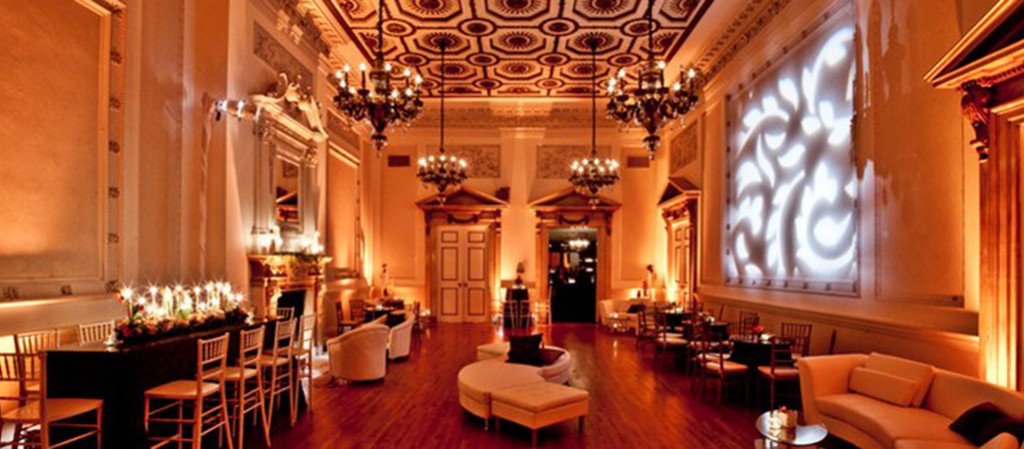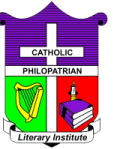
The Stotesbury mansion, which is currently the home of the Philopatrian Literary Institute, is a Philadelphia landmark. The mansion is registered on the National Register of Historic Places. It was built in 1870 by architect Wilson Eyre, Jr. who had been commissioned by Thomas McKean to build a spectacular home for his son, Henry McKean, as a wedding present. Thomas McKean was the namesake and descendent of one of the signers of the Declaration of Independence.
In 1890, upon the death of Henry McKean, Mr. Edward T. Stotesbury purchased the home as an addition to his adjoining residence. At the time of purchase, the press heralded it as the largest and grandest townhouse in all of the East Coast. But that was only the beginning, because the man referred to as one of the wealthiest Philadelphians was to renovate the townhouse for more than 1.5 million dollars. In 1911, in anticipation of his upcoming nuptials, he commissioned the famous designer from England, Sir Joseph Duveen, who was the designer to such families as the Morgans, Vanderbilts and the Rockefellers. Several of the most elaborate additions were the Tiffany glass skylight above the grand staircase (now removed), the marble entryway, Dolly Madison’s fireplace from the White House that was purchased by the soon-to-be Mrs. Stotesbury in 1890, and the squash court installed on the fifth floor installed for Mrs. Stotesbury’s son, James H.R. Cromwell. Her son enjoyed the court for 10 years before marrying Doris Duke.
The renovations were completed in 1912 in time for the wedding of Mr. Stotesbury to the widow Mrs. Lucretia Roberts Cromwell. The wedding was held at the townhouse with such attendees as Mr. and Mrs. J.P. Morgan and President Taft. Mr. Morgan was a frequent visitor to the townhouse because of his banking partnership with Mr. Stotesbury. Since 1882, Mr. Stotesbury was a partner in the Morgan banking houses and then soon after became the president of Drexel and Company, the investment brokerage firm.
The new Mrs. Stotesbury catapulted Mr. Stotesbury into the elite Philadelphia society. Prior to his marriage, he had been somewhat of a recluse except for his business and club functions, including being a board member for numerous corporations and President of the Union League and The Racquet Club, which were very important to him. But as a result of Mrs. Stotesbury’s influence, they soon became the most popular hosts in the city.
In 1914, Mrs. Stotesbury felt that the townhouse needed a ballroom for entertaining. Mr. Stotesbury commissioned Lord Joseph Duveen once again for the 1/2 million dollar ballroom construction. They imported a Georgian ballroom that was in the Lord’s manor in England. It took 500 craftsmen over a year to reassemble the ballroom in the townhouse. They imported the crystal Louis XV period chandeliers, the 14th Century Italian marble fireplace, the gold ceiling panels, the Beauvais tapestry that represented abundance hung from the Italian fireplace, and the marble Corinthian columns. In addition, the innovative ideas of the designer led to the installation of an organ and orchestra area (“fiddlers booth”) above the two entrance doors to the ballroom, for their private entertainment pleasures. At the entrance to the ballroom, a fountain splashed softly and one could pause for a moment on the small granite benches to enjoy the effect.
Upon the opening in January, 1916, the Public Ledger wrote that “Madame de Pompadour had come to Walnut Street bringing her good taste and passion for elegance.”
The ballroom soon became the scene of many brilliant social functions. On one occasion, President Taft, who was in town to attend a party at the Union League, came to midnight dinner with several opera stars from the old Hammerstein House. These after-opera parties were quite frequent and brought together many notables including Presidents McKinley and Theodore Roosevelt and General Douglas MacArthur (who went on to marry Mr. Stotesbury’s daughter).
In addition, in an effort for the wealthy families to continue to entertain during the Prohibition, the Stotesbury’s installed a mirror maze and hidden doors in order to divert authorities from their extravagant affairs during this period. The mirror maze continued to be effective as a burglar device until 1958 when it was disassembled to become the hall of mirrors that currently exists.
As the Stotesbury’s began to entertain more often, Lord Joseph Duveen convinced Mrs. Stotesbury that her “petit palais” no longer suited the grand dimensions of their new life. It was then that Mr. Stotesbury purchased 300 acres outside Chestnut Hill to build what would become known as Whitemarsh Hall. To build the estate, consisting of 146 rooms, took 83 million dollars and three years. Upon the completion of the home in 1921, the Stotesbury’s did not spend much time at the townhouse.
In 1922, Mr. Stotesbury placed the townhouse up for sale. Due to the exorbitant price, the home did not sell until October, 1925 when the Philopatrian Club purchased a portion of the townhouse for $400,000. Thomas Logue, Esquire, a long-time Philopatrian, negotiated the deal with Mr. Stotesbury. The club also purchased a large portion of the priceless collection of paintings located in the home. The Philopatrians sold their clubhouse at 1411-13 Arch Street to the U.G.I. Company and moved into 1923 Walnut Street in March, 1926. One of the most popular additions to the new clubhouse was the Billiard Room. The Philopatrians brought their Brunswick, Balke, Callender Company pool table and billiard table from the old clubhouse to the new location. The tables date back to 1912 and are longer than regulation tables of this day In fact, “Minnesota Fats” often played with members and at pool exhibitions at the new clubhouse.
The first event held by the Philopatrians was a Debutante Ball for a member’s daughter, Betty O’Brien from Newtown Square. The imposing Brownstone Mansion from Philadelphia’s age of elegance has been kept in excellent condition, thereby maintaining the history that is so very grand. In fact, we even managed to keep Dolly Madison’s fireplace when First Lady Jacqueline Kennedy tried to negotiate for its purchase in 1961 when she was renovating the White House.
Since November 1992, the Philopatrians have shared some of its great fortunes with Philadelphia by allowing outside affairs to be held at the mansion. Numerous functions including weddings, corporate dinners, meetings and receptions are shared at this historic mansion forever adding to its rich history. For more information on catering, visit Feastivities Catering.
